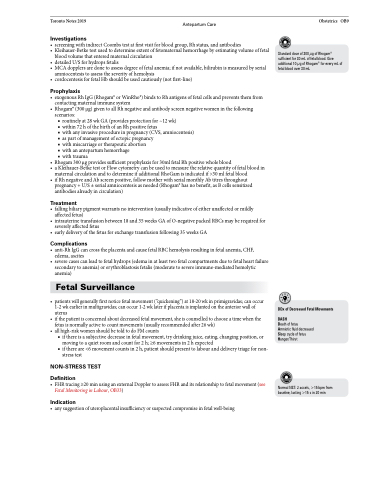Page 849 - TNFlipTest
P. 849
Toronto Notes 2019 Antepartum Care
Investigations
• screeningwithindirectCoombstestatfirstvisitforbloodgroup,Rhstatus,andantibodies
• Kleihauer-Betketestusedtodetermineextentoffetomaternalhemorrhagebyestimatingvolumeoffetal
blood volume that entered maternal circulation
• detailedU/Sforhydropsfetalis
• MCAdopplersaredonetoassessdegreeoffetalanemia;ifnotavailable,bilirubinismeasuredbyserial
amniocentesis to assess the severity of hemolysis
• cordocentesisforfetalHbshouldbeusedcautiously(notfirst-line)
Prophylaxis
• exogenousRhIgG(Rhogam®orWinRho®)bindstoRhantigensoffetalcellsandpreventsthemfrom contacting maternal immune system
• Rhogam®(300μg)giventoallRhnegativeandantibodyscreennegativewomeninthefollowing scenarios:
■ routinely at 28 wk GA (provides protection for ~12 wk)
■ within 72 h of the birth of an Rh positive fetus
■ with any invasive procedure in pregnancy (CVS, amniocentesis) ■ as part of management of ectopic pregnancy
■ with miscarriage or therapeutic abortion
■ withanantepartumhemorrhage
■ with trauma
• Rhogam 300 μg provides sufficient prophylaxis for 30ml fetal Rh positive whole blood
• aKleihauer-BetketestorFlowcytometrycanbeusedtomeasuretherelativequantityoffetalbloodin
maternal circulation and to determine if additional RhoGam is indicated if >30 ml fetal blood
• ifRhnegativeandAbscreenpositive,followmotherwithserialmonthlyAbtitresthroughout
pregnancy + U/S ± serial amniocentesis as needed (Rhogam® has no benefit, as B cells sensitized antibodies already in circulation)
Treatment
• fallingbiliarypigmentwarrantsnointervention(usuallyindicativeofeitherunaffectedormildly affected fetus)
• intrauterinetransfusionbetween18and35weeksGAofO-negativepackedRBCsmayberequiredfor severely affected fetus
• earlydeliveryofthefetusforexchangetransfusionfollowing35weeksGA
Complications
• anti-RhIgGcancrosstheplacentaandcausefetalRBChemolysisresultinginfetalanemia,CHF, edema, ascites
• severecasescanleadtofetalhydrops(edemainatleasttwofetalcompartmentsduetofetalheartfailure secondary to anemia) or erythroblastosis fetalis (moderate to severe immune-mediated hemolytic anemia)
Fetal Surveillance
• patientswillgenerallyfirstnoticefetalmovement(“quickening”)at18-20wkinprimigravidas;canoccur 1-2 wk earlier in multigravidas; can occur 1-2 wk later if placenta is implanted on the anterior wall of uterus
• if the patient is concerned about decreased fetal movement, she is counselled to choose a time when the fetus is normally active to count movements (usually recommended after 26 wk)
• allhigh-riskwomenshouldbetoldtodoFMcounts
■ if there is a subjective decrease in fetal movement, try drinking juice, eating, changing position, or
moving to a quiet room and count for 2 h; ≥6 movements in 2 h expected
■ if there are <6 movement counts in 2 h, patient should present to labour and delivery triage for non-
stress test
NON-STRESS TEST
Definition
• FHRtracing≥20minusinganexternalDopplertoassessFHRanditsrelationshiptofetalmovement(see Fetal Monitoring in Labour, OB33)
Indication
• anysuggestionofuteroplacentalinsufficiencyorsuspectedcompromiseinfetalwell-being
Obstetrics OB9
Standard dose of 300 μg of Rhogam®
sufficient for 30 mL of fetal blood. Give
® additional10μgofRhogam foreverymLof
fetalbloodover30mL
DDx of Decreased Fetal Movements
DASH
Death of fetus
Amniotic fluid decreased Sleep cycle of fetus Hunger/Thirst
Normal NST: 2 accels, >15 bpm from baseline, lasting >15 s in 20 min


